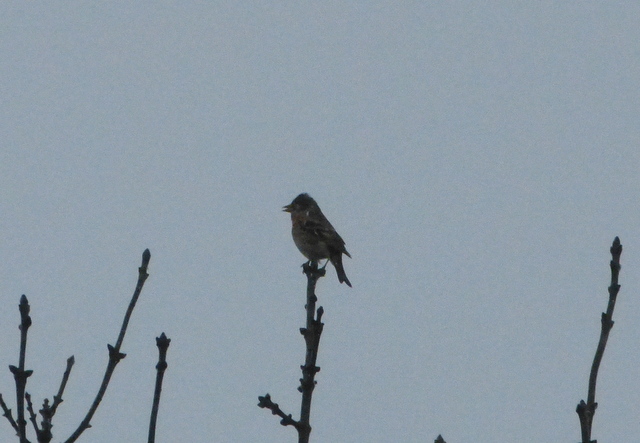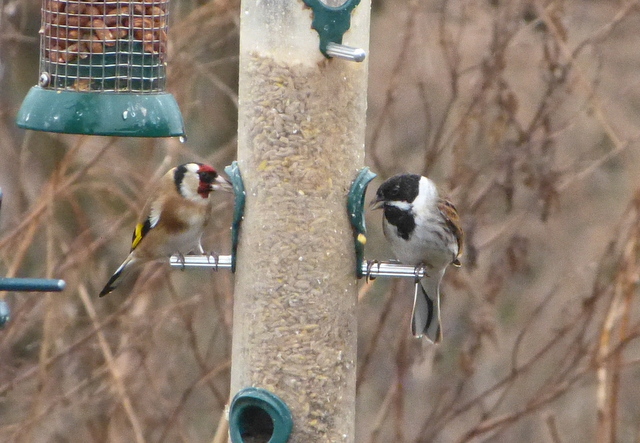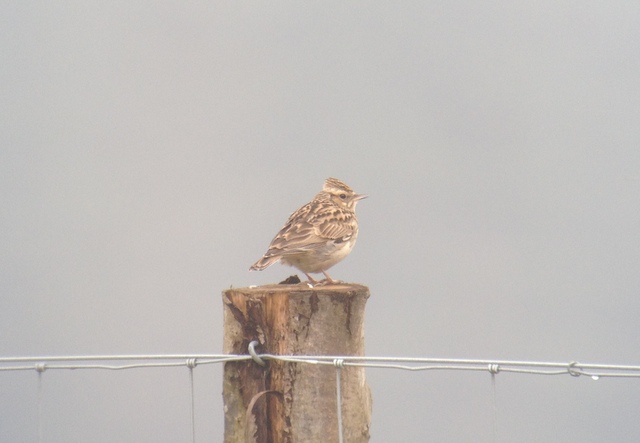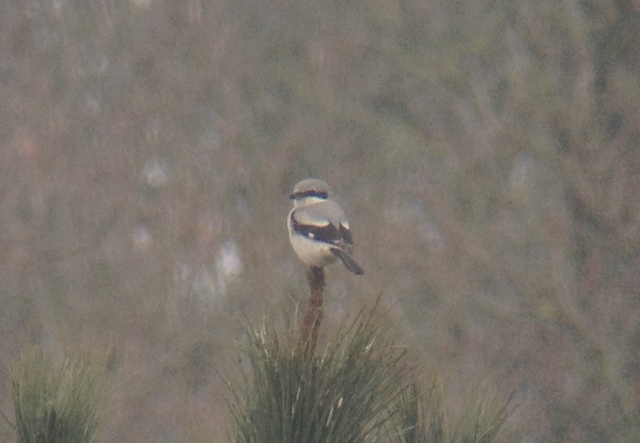Another Brecks Tour today. The weather was not great, to say the least. There was meant to be “some showery rain” in the morning, but it was coming down hard first thing and it carried on well into the afternoon, on and off, with mist at other times. At least we got the forecast brighter intervals later on. As usual, it didn’t stop us getting out and we had seen some really good birds by the end of the day.
We met up in Mundford. As we loaded up the car, in the pouring rain, a Brambling was singing in the top of a tree in a garden right in front of us. It should really be on its way to Scandinavia, rather than singing here. A nice way to start.
 Brambling – singin’ in the rain in a Mundford garden
Brambling – singin’ in the rain in a Mundford garden
Our first stop was at Lynford Arboretum. Despite the persistent rain, a Marsh Tit was singing in the car park and a Goldcrest was singing in the Arboretum itself. There were lost of Chaffinches feeding down in the leaves in front of the gate, but no sign of the hoped for Hawfinch, either on the ground or in the trees nearby. A couple of Redwings hopped out onto the path and, as we walked on, we could see that a large flock was feeding in the rough paddock nearby. They flew up into the trees as we passed.
Walking round the back of the Arboretum didn’t produce any of the birds we had hoped to see either. We did see a variety of tits, Goldcrests and a Treecreeper, but that was about it. The trees were not providing much shelter from the rain for us, so we decided to try another tack.
We drove on to Lakenheath Fen. As we arrived in the car park, the rain had eased off and the sky looked a touch brighter, which was promising. From the warmth of the Visitor Centre, the staff kindly pointed out a Water Rail which was standing on the edge of the reeds on the pool in front.
 Water Rail – showing well from the Visitor Centre
Water Rail – showing well from the Visitor Centre
We decided to head round to the Washland viewpoint. As we walked round past the feeders, the usual mass of Reed Buntings scattered out to the reeds.
 Reed Bunting – the feeders always attract lots of these (& Goldfinch)
Reed Bunting – the feeders always attract lots of these (& Goldfinch)
From up on the river bank, we could see a few Little Egrets, but no sign of any of the Great White Egrets. There were lots of other things to look at. A Kingfisher flashed past and perched up by the river for a minute. Plenty of ducks on Hockwold Washes included Wigeon, Gadwall, Mallard, Teal, Shoveler and Tufted Duck amongst them. A Great Crested Grebe sailed along the river, resplendent in its breeding plumage. A couple of Cetti’s Warblers sang loudly from the bushes behind us.
With the rain still holding off, we decided to explore the reserve. It was misty and damp as we walked west along the river bank. A Barn Owl appeared, taking advantage of the break in the rain to attempt to hunt, but it was chased off by a Carrion Crow. A Marsh Harrier quartered back and forth along the river bank ahead of us. But there was still no sign of the Great White Egret and the Cranes were also lying low. We checked out the paddocks and the marshy fields across the river, all to no avail. A Chiffchaff was singing from the bushes in the reedbed, the first we’ve heard this spring. Then the rain started again and we sought shelter in the Joist Fen viewpoint. When it finally eased off, we decided to head back.
The Great White Egret had been reported from the Washland viewpoint while we were out on the reserve, so we had a quick look. But once again it had disappeared by the time we got there. It felt like it wasn’t going to be our day. A second Chiffchaff heard singing was no compensation. We were back in the car and heading off when we spotted a large white shape on the pool by the road just on the Norfolk side of the river. We pulled up and confirmed it was indeed the Great White Egret. Success at last! We had great views of it feeding, its long neck outstretched.
 Great White Egret – we finally found it on the pool by the road today
Great White Egret – we finally found it on the pool by the road today
Things were looking up, so we headed back into the Forest. It was still damp and misty, but at least it was not raining now. After lunch, we walked in along one of the rides to a large clearing. We could hear a Woodlark singing and we quickly picked up a pair circling overhead. They dropped down on the edge of a track and started feeding. As we walked over, the male Woodlark suddenly took off singing again, right overhead. We looked over, and we could see a second pair flying over – the male was clearly advertising his territorial rights!
We watched the female Woodlark feeding amongst the dead bracken and dry grass on the edge of the trees. Eventually, the male walked back in to join her. A pair of Yellowhammers also dropped down from the trees to feed nearby. The Woodlarks eventually flew up and the male started singing again, first from one of the posts on the deer fence and then from a pile of brash on the ground. We got great views of him through the scope.
 Woodlark – singing from a fence post
Woodlark – singing from a fence post
While we were there, a lone Common Buzzard broke from the trees and flew across the clearing, but there was no sign of any other activity today – not a great surprise given the weather. So, having enjoyed the Woodlarks, we headed off again.
It seemed like it might be brightening up, so we drove back to Lynford Arboretum for another go – but on the way we found ourselves back in the rain yet again. It was more like drizzle by the time we got there, so we put our coats back on and walked back up to the gate. A few hardy souls were standing around and encouragingly a Hawfinch had been seen about 10 minutes earlier. Scanning the ground, we could see no sign of it but we did see a little group of Bramblings.
Just past the gate, we could hear a Hawfinch calling and finally one flew up and landed in the top of a pine tree. We all got to see it through the scope before it dropped back into the trees again. Another success – our perseverance was starting to pay off.
Then a Firecrest started singing behind us. It sounded as if it was some way off through the trees at first, but seemed to be coming nearer, so we set off to meet it halfway. Unfortunately, it stopped as soon as we did so and we never did find it. It was hard to see anything in the trees in the mist and drizzle. Perhaps our luck was now failing us?
We walked round the Arboretum again. The Redwings were now up in the trees and several were singing – another species which will shortly be heading north to breed. We could also hear more Hawfinches calling and we got a good look at another perched in the top of a deciduous tree, then a second in a larch, but they were not hanging around. One Hawfinch disappeared into the grounds of the Hall and a second flew overhead in the direction of the paddocks. We had managed some decent views of them now, so decided to try one more thing.
We headed back into the forest and finally the sun started to come out and the mist lifted. It didn’t take us long to find the Great Grey Shrike, in pretty much exactly the same place it had been a couple of days ago. It was some way off at first, but distinctive even at a distance – perched high up in the top of a tree. We had a quick look at in the scope and then worked our way round for a closer view. It was rather mobile, moving around from tree to tree, presumably taking advantage of the improvement in the weather to hunt. A cracking bird.
 Great Grey Shrike – scanning for prey from the top of a pine tree
Great Grey Shrike – scanning for prey from the top of a pine tree
It was getting late and we were going to call it a day, but everyone agreed to one last quick stop – a little detour on our way back. We had been frustrated by the tantalising performance from the Firecrest at the Arboretum earlier, so we decided to try Santon Downham churchyard. The hazy sunshine was now on the trees and it seemed perfect. Right on cue, a Firecrest started singing. From round on the roadside, we could see it flicking round in a deciduous tree, flycatching. It came down lower and we could see the black and white striped face and the bronzey patch on the neck. A perfect way to end the day.
So the weather hadn’t been great, but we had managed to see many of the Brecks specialities anyway. Not a bad haul, considering.
















